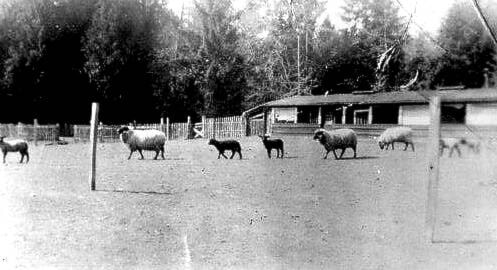Elida Peers | Contributed
Most of us noticed a resurgence of interest in locally-based agriculture, indeed a welcome trend in today’s high-powered internationally-focused world. Our photo shows the small farm of Ed and Sybil Banner on Parklands Road in Saseenos in 1950.
The Banner family’s new farm home, encompassing four acres, meant Ed no longer drove west to work in Shirley, as when he became a longshoreman, it meant a shorter commute to Victoria. Mainly it was Sybil and the three kids who looked after most of the farm chores. A flock of sheep is shown here going out to pasture.
MORE SOOKE HISTORY: Adventure followed Major George Nicholson wherever he went
In the 1950s, a lot of knitting was being done, especially “Indian sweaters,” so there was a market for raw wool in addition to lamb and mutton. When black lambs arrived in spring, of course, they were especially prized, as they provided the natural colour for designs in the raw wool sweaters. A cow and chickens were part of the farm’s livestock as well.
One of Ed Banner’s treasured farm hobbies was beekeeping, and daughter Darla recalls her fascination with getting garbed up in all the protective beekeeping gear to watch him deal with the hives. Darla remembers he kept bees for many years and sold his special fireweed honey for $20 a pail.
Many locals will recall that Ed Banner passed away at age 101 a few months ago. In the mid-1960s, he and Sybil left the farm and moved to a home on Church Road, where Ed continued to commute to his longshoreman’s job until retiring in 1982.
Sybil Banner was a dedicated community worker. As a child from Britain, she had come to Victoria and became a devoted advocate for her new country. She contributed to the Sooke Community Association, Sooke Athletic Association, Shirley and Sooke Women’s Institutes, and the Sooke Fall Fair right to the end of her days.
Sadly, her early death left Ed alone, but relatives like daughter Darla tried to keep him engaged with trips to the north country.
The sheds seen in this photo were once used to house mink, raised for their fur by Pete and Jessie Duncan after they bought the acreage from Franco-Canadian Company, the firm that subdivided Saseenos, back in the early 1920s. Another form of agriculture.
•••
Elida Peers is the historian of the Sooke Region Museum. Email historian@sookeregionmuseum.com.
editor@sookenewsmirror.com
Like us on Facebook and follow us on Twitter
